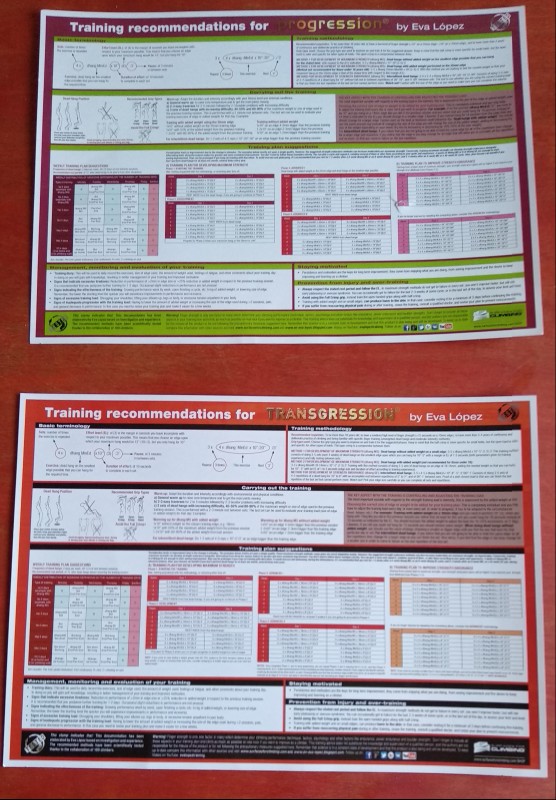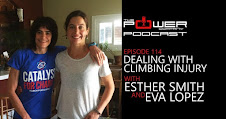Versión en español

Warm-up is highly recognized as an essential part of any sports activity. The aim of warm-up is to increase muscle-tendon
suppleness, stimulate peripheral blood flow, increase the temperature of the body, muscle tendon and connective tissue; and enhance free, coordinated
movement.
However...The science about how to warm up is not well developed; we haven’t answered the big questions yet: about
whether to warm up or why to warm up (Fradkin et al, 2010)...
After one of my last posts, somebody asked me:
 | ||
| During endurance routes, performance is enhanced by a good warm-up, because it allows your body to deliver more oxygen to the muscles right from the start of the workout, and reduces the temporary oxygen debt (Hojoblou et al, 2005) Picture: Dani Andrada - Corazón de Ensueño, 8c FA; China. Photo by Sam Bie. Source: www.sambie.fr |
After one of my last posts, somebody asked me:
MY ANSWER:"Since you so easily entertain all my questions I will ask another seemingly unrelated question that I think in some strange way applies to your studies and training.
I have noticed that most programs mention warm-ups, but on the other hand there are a few notable climbers who seem to jump straight onto difficult boulders and routes with no apparent warm up. In fact (not sure if you know who he is but...) boon speed of pusher developed a hangboard years ago after noticing that he was stronger from doing short hard hangs randomly (sounds a lot like your training) with no real training warm up just throughout the day hang for a few seconds and go on with your day... which seemed to work for him in sending his 8c(+) route project. To make a short story long - is there any evidence that warm ups may or may not be necessary in this type of training? it seems very curious"
It's not so easy! :-D but I apply a WIN/WIN philosophy (I LEARN/YOU LEARN) that's pretty motivating.
I ignore the exact methodology that Boone Speed used and its development as the sets went by (evolution in edge depth, EL or added weight), but let's suppose he didn't use Pavel Tsatsouline's method (He stated that if you want to get better at doing pull ups, you do more pull ups. But don't try and do 100 in a workout (setsxreps). Instead, you perform many sets of the same exercise over and over again spread along the whole day to improve performance on said exercise.What ends up happening is you end up doing 15 to 20 pull ups as many as 5-10 times a day); this would be effective when we are learning a new exercise or doing sustained climbing exercises in the gym... but not when we want to improve our maximum strength.
Instead we will suppose he did 2-3 sessions of 2-3 sets each; then:
I believe that probably the first few sets that Speed performed served him as a warmup, perhaps without him being conscious of it. Otherwise would mean he was following Pavel's, and so failing to achieve the potential benefits that he could have enjoyed by doing 3-5 sets in one session or 2-4 sets in two sessions.
It has been shown that greater scores in maximum strength and power are obtained when an appropriate warming-up protocol is followed, including the same exercise the training consists of, and several sets of submaximal loads with the same duration/reps as the training itself. Also, these acute positive effects are bigger for the stronger and/or more skilled athletes.
Moreover, the results obtained by Abad et al (2011), support the advisability of performing a moderate intensity general warm-up in addition to the specific warm-up before maximum strength tests/training. The general warm-up intends to raise muscle temperature, whereas the specific warm-up aims to increase neuromuscular activation.
I ignore the exact methodology that Boone Speed used and its development as the sets went by (evolution in edge depth, EL or added weight), but let's suppose he didn't use Pavel Tsatsouline's method (He stated that if you want to get better at doing pull ups, you do more pull ups. But don't try and do 100 in a workout (setsxreps). Instead, you perform many sets of the same exercise over and over again spread along the whole day to improve performance on said exercise.What ends up happening is you end up doing 15 to 20 pull ups as many as 5-10 times a day); this would be effective when we are learning a new exercise or doing sustained climbing exercises in the gym... but not when we want to improve our maximum strength.
Instead we will suppose he did 2-3 sessions of 2-3 sets each; then:
I believe that probably the first few sets that Speed performed served him as a warmup, perhaps without him being conscious of it. Otherwise would mean he was following Pavel's, and so failing to achieve the potential benefits that he could have enjoyed by doing 3-5 sets in one session or 2-4 sets in two sessions.
It has been shown that greater scores in maximum strength and power are obtained when an appropriate warming-up protocol is followed, including the same exercise the training consists of, and several sets of submaximal loads with the same duration/reps as the training itself. Also, these acute positive effects are bigger for the stronger and/or more skilled athletes.
 |
| Double Dyno - Bleau 2009- photo: Udo Neumann - Source: www.udini.com |
Moreover, the results obtained by Abad et al (2011), support the advisability of performing a moderate intensity general warm-up in addition to the specific warm-up before maximum strength tests/training. The general warm-up intends to raise muscle temperature, whereas the specific warm-up aims to increase neuromuscular activation.
 Nonetheless, playing devil's advocate, I will add that for boulder problems that last for more than 1', power endurance routes or power training like campus board or dynos, "less is more", because it has been observed that too long a warming-up, or too intense and without enough rest period before the actual competition can impair performance, especially when the sport level is not very high. The reason is that those types of warming-up could cause significant fatigue and impair subsequent performance because of the reduction in high-energy phosphates, which are the key substrates for performance in those activities (Hashbullah et al, 2011, Mujika et al, 2011; Tomaras and MacIntosh, 2011).
Nonetheless, playing devil's advocate, I will add that for boulder problems that last for more than 1', power endurance routes or power training like campus board or dynos, "less is more", because it has been observed that too long a warming-up, or too intense and without enough rest period before the actual competition can impair performance, especially when the sport level is not very high. The reason is that those types of warming-up could cause significant fatigue and impair subsequent performance because of the reduction in high-energy phosphates, which are the key substrates for performance in those activities (Hashbullah et al, 2011, Mujika et al, 2011; Tomaras and MacIntosh, 2011). Lastly, I find two aspects of the training you describe that are positive, and in fact are among the principles of the methodology I propose:
- Short hanging times ("a few seconds" as you recount, 3"-10'' for high level, 10"-15'' for medium and low level) and high intensity to increase maximum strength (getting neural effects but not hypertrophy).
- Complete rest periods between sets and several brief strength training sessions distributed along the day. According to the scientific literature we can optimally train our strength by doing sessions of no more than 45'-60' with a pause of 30' or more between them. By this I don't want to give the impression that it's better to do several dead hang sessions on the same day than just one session, it's not?
However, you can do a finger strength session in the morning, and a bouldering session in the evening.
On a related note, the effects of a good warming-up last for 45-80', and even more according to some authors (if the ambient temperature is right).
 A different issue is the psychological influence on motivation or the difficulty to stay focused across long rest periods, but that is a matter of personal preference.
A different issue is the psychological influence on motivation or the difficulty to stay focused across long rest periods, but that is a matter of personal preference.

IN SUMMARY
When doing dead hangs we could follow this warming-up suggestions that can be found in the posters that come with Progression and Transgression fingerboards:
REFERENCES:
- Complete rest periods between sets and several brief strength training sessions distributed along the day. According to the scientific literature we can optimally train our strength by doing sessions of no more than 45'-60' with a pause of 30' or more between them. By this I don't want to give the impression that it's better to do several dead hang sessions on the same day than just one session, it's not?
However, you can do a finger strength session in the morning, and a bouldering session in the evening.
 |
| Nacho Sánchez ; Bouldering World Cup. Barcelona 2011 - Photo: David Munilla |


IN SUMMARY
When doing dead hangs we could follow this warming-up suggestions that can be found in the posters that come with Progression and Transgression fingerboards:
- Moving the joints of upper body, shoulders, elbows, neck and fingers;
- Following with 2-3 easy traverses for 2 to 5 minutes followed by 2-3 boulder problems with increasing difficulty; or several progressive sets on easy holds of the hangboard if we are at home;
- And then 2-3 sets of 10 seconds with 40-50%, 80% and 90% of the load used the previous session.
REFERENCES:
- Abad et al (2011): Combination of general and specific warm-ups improves leg-press one repetition maximum compared with specific warm-up in trained individuals. J Strength Cond Res. Aug;25(8):2242-5. Altamirano et al (2011): Effects of Warm-up on Peak Torque, Rate of Torque Development, and Electromyographic and Mechanomyographic Signals. J Strength Cond Res. Sep 28
- Brown et al (2008): The effect of warm-up on high-intensity, intermittent running using nonmotorized treadmill ergometry. J Strength Cond Res. May;22(3):801-8.
- Burkett et al (2005): Effects of prior warm-up regime on severe-intensity cycling performance. Med Sci Sports Exerc. May;37(5):838-45.
- Burnley et al (2005): Effects of prior warm-up regime on severe-intensity cycling performance. Med Sci Sports Exerc. May;37(5):838-45.
- Fradkin et al (2006): Effects of warming-up on physical performance: a systematic review with meta-analysis. J Strength Cond Res. Jan;24(1):140-8.
- Gourgoulis et al (2003): Effect of a submaximal half-squats warm-up program on vertical jumping ability. J Strength Cond Res. May;17(2):342-4.
- Hajoglou et al (2005): Effect of warm-up on cycle time trial performance. Med Sci Sports Exerc. Sep;37(9):1608-14.
- Hashbullah et al (2010): Effects of different warm-up protocols and no warm up on speed performance among football players. Science and Social Research (CSSR), 2010 International Conference on Issue Date: 5-7 Dec
- Hawley et al, (1989): Effects of a task-specific warm-up on anaerobic power. Br J Sports Med. Dec;23(4):233-6.
- Mujika et al (2011): Warm-up Intensity and Duration Affect Traditional Rowing Time Trial Performance. Int J Sports Physiol Perform. Dec 12
- Saez Saez de Villarreal et al (2007): Optimal warm-up stimuli of muscle activation to enhance short and long-term acute jumping performance. Jul;(4):393-401
- Sotiropoulos, K. et al. (2010): Effects of warm-up on vertical jump perf ormance and muscle electrical activity. Journal of Sports Science and Medicine, 9, 326-331
- Tomaras, E.K and MacIntosh, B.R. (2011): Less is more: standard warm-up causes fatigue and less warm-up permits greater cycling power output. Jul;111(1):228-35
- Wittekind, A. and Beneke, R. (2011): Metabolic and performance effects of warm-up intensity on sprint cycling. Scand J Med Sci Sports. Dec;21(6)
- Wittekink et al (2012): Warm-up effects on muscle oxygenation, metabolism and sprint cycling performance. Eur J Appl Physiol. Jan 3
- Zois et al (2011): High-intensity warm-ups elicit superior performance to a current soccer warm-up routine. J Sci Med Sport. Nov;14(6):522-8. Epub 2011 Sep 9.















 https://orcid.org/0000-0003-0304-5290
https://orcid.org/0000-0003-0304-5290







